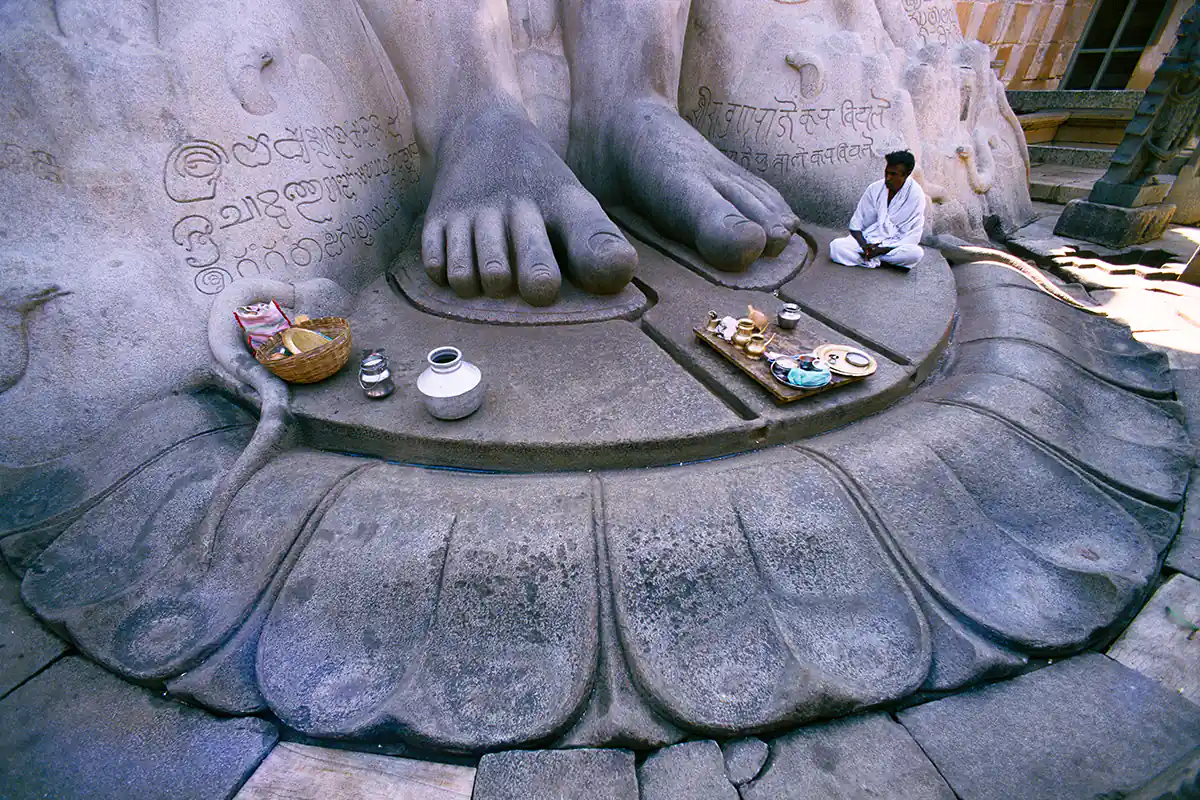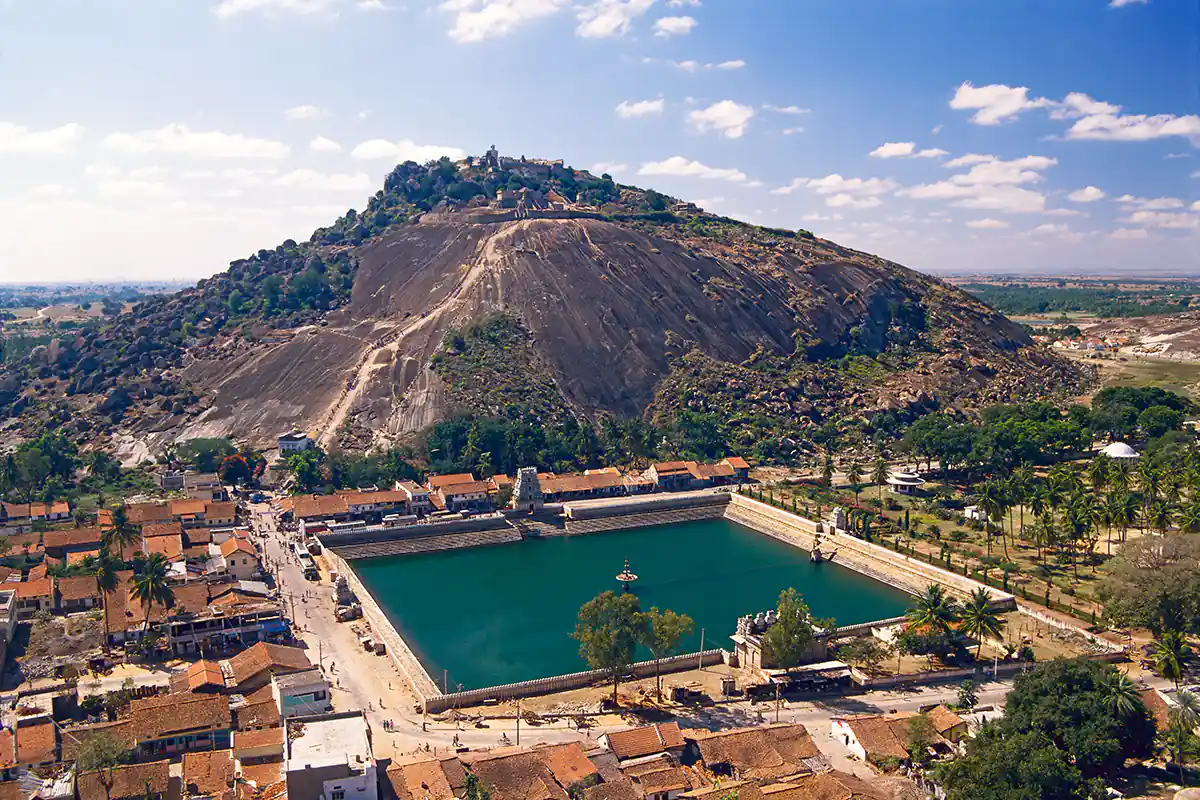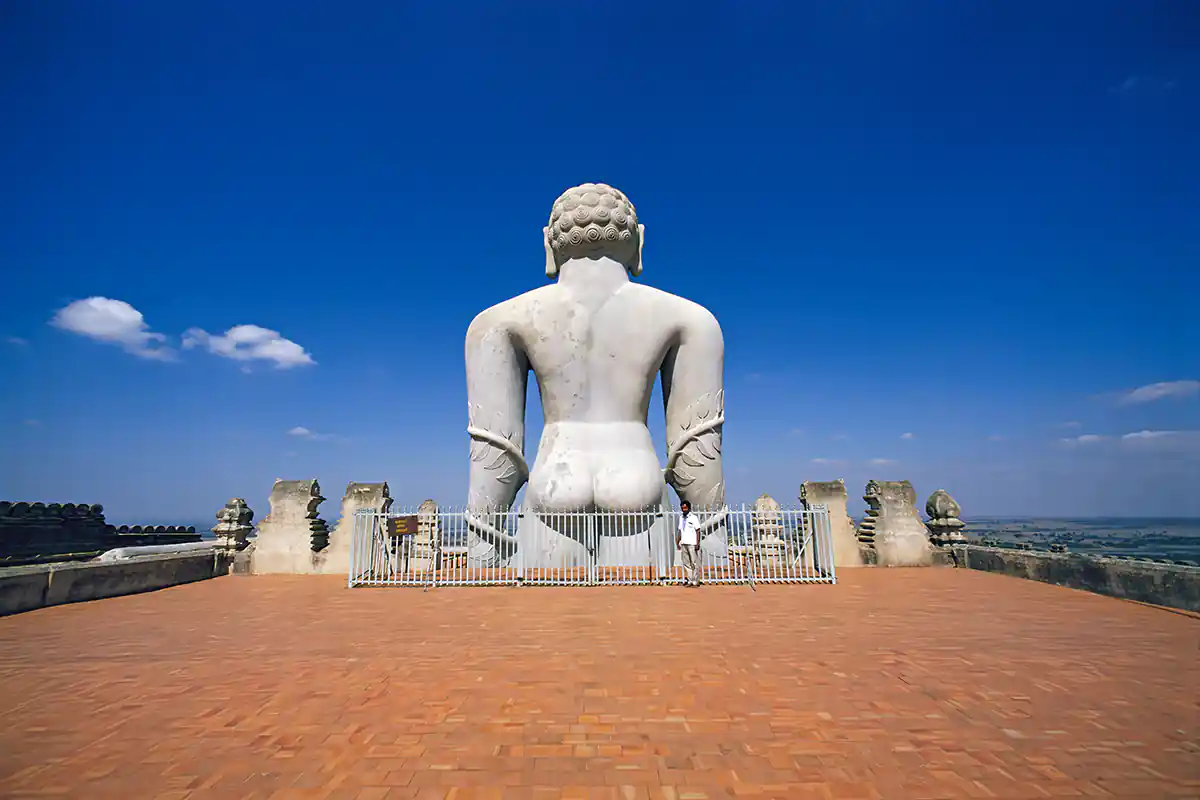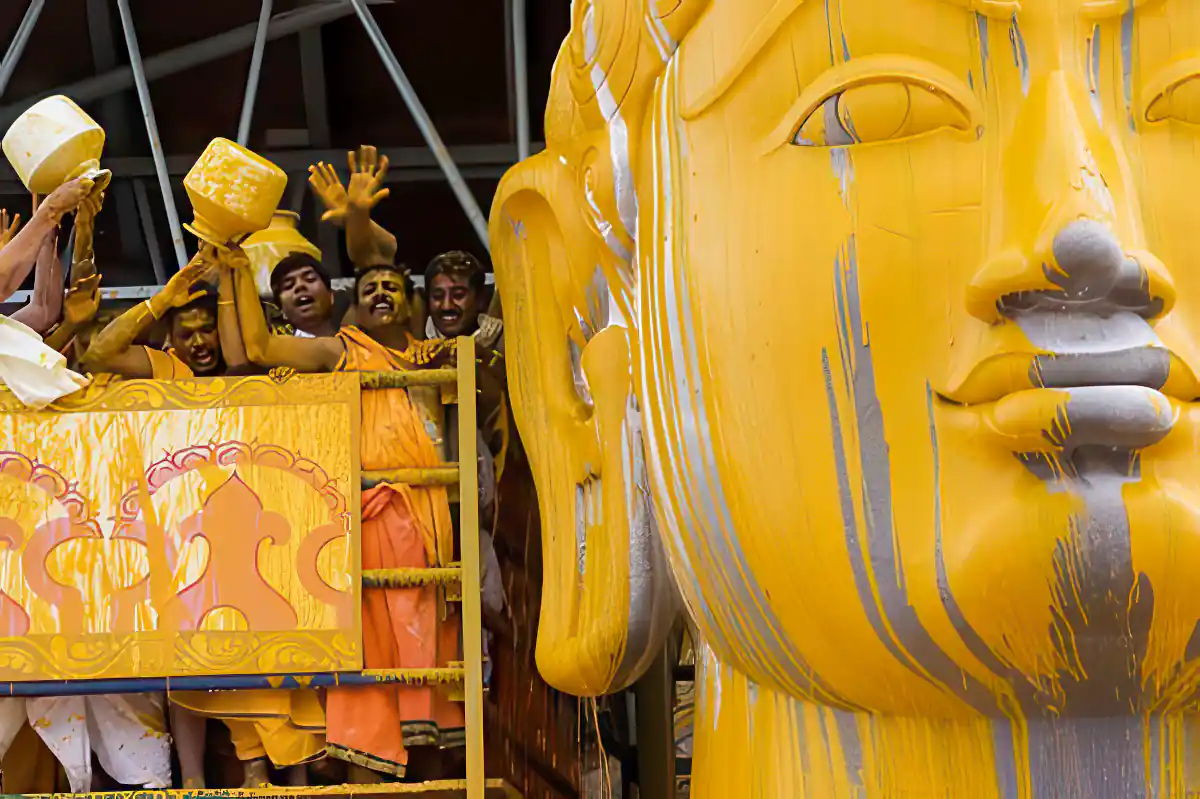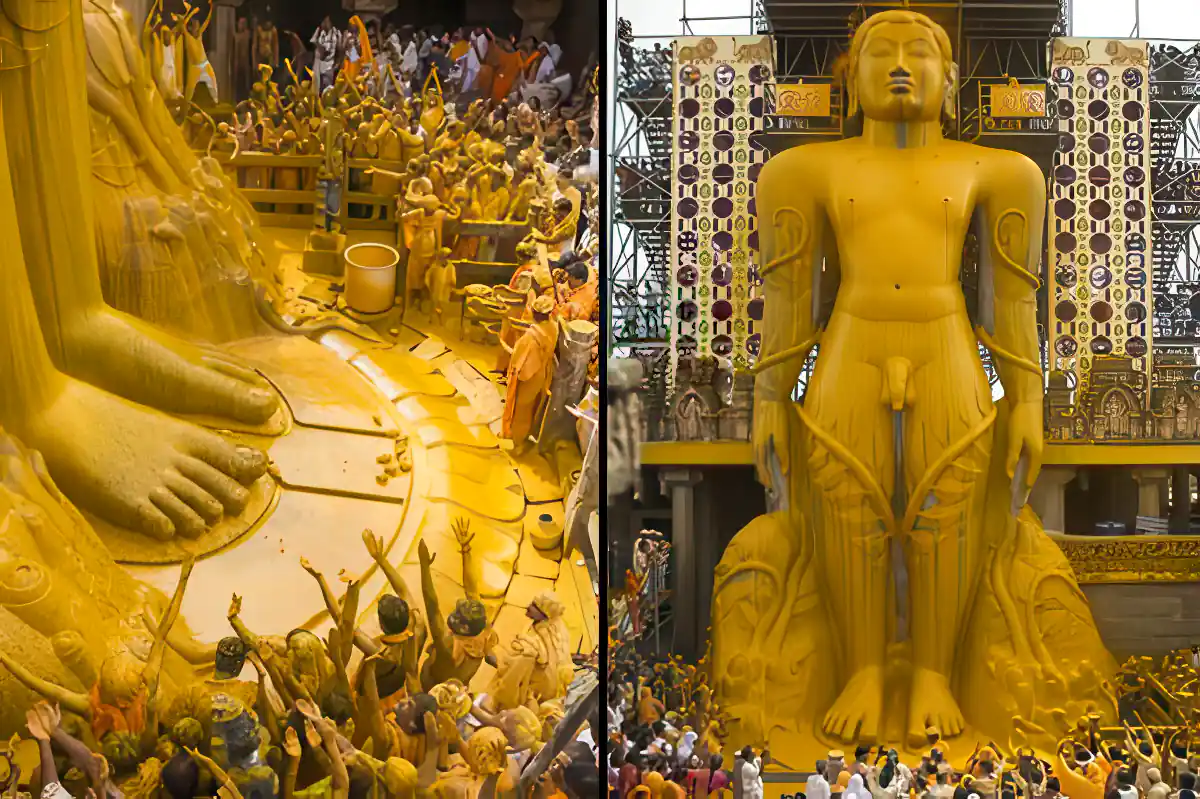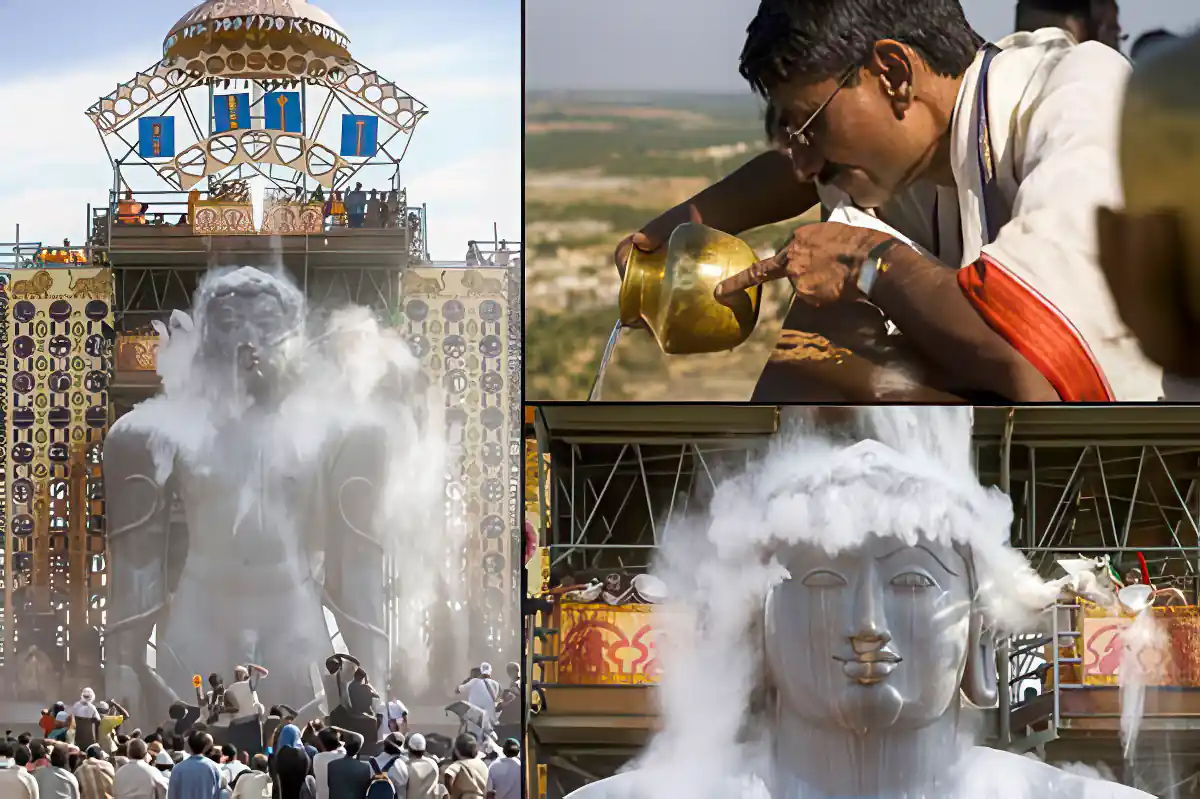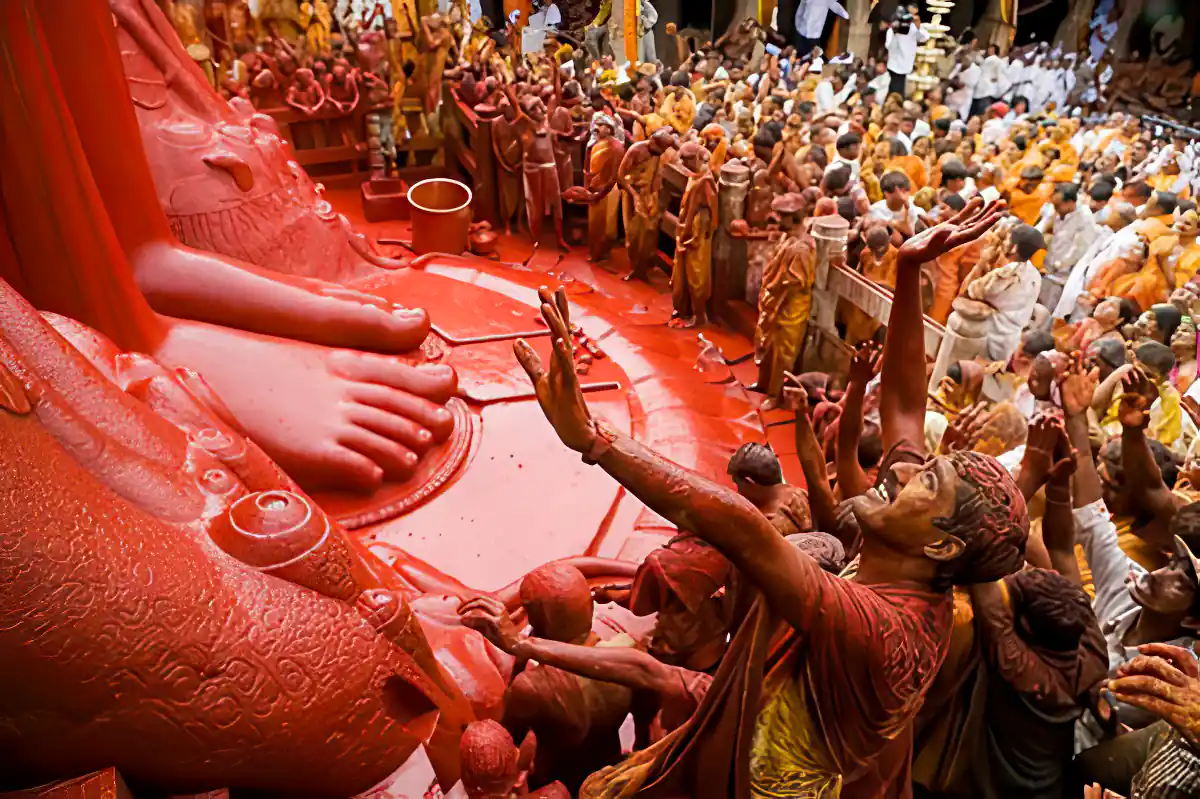Shravanabelagola
The hill of Shravanabelagola, 120 kilometers west of Bangalore in Karnataka, is a noted place of pilgrimage for the Jains. The large hill, called Vindhyagiri or Per-kalbappu, is 3347 feet above sea level. A flight of 614 steps, finely chiseled into the mountain's granite, leads to the summit, where stands an open court and the great statue of Sri Gomatheswar. Shravanabelagola means 'the monk on the top of the hill,' and hermits, mystics, and ascetics have resided here since at least the 3rd century BC. The hill was thickly wooded in those early times, and hermits could feed themselves from the forest vegetation. Near the middle of the 10th century AD, temples began to be constructed on the hill, and from that time, the place has become one of the most important pilgrimage sites of the Jain religion. The 58-foot, 8-inch statue of Sri Gomatheswar, carved between 978 and 993 AD out of the granite bedrock of the mountain, is the tallest free-standing statue in the world. Sri Gomatheswar, also known as Bahubali, was the son of the legendary first Tirthankara, Adinatha (Tirthankaras are the mythical, enlightened sages of Jainism).
The chief festival of Shravanabelagola is Maha Masthaka Abhisheka, or the 'Head Anointing Ceremony.' Before the festival, an enormous wooden scaffolding was built around the statue of Sri Gomatheswar, and more than one million pilgrims assembled around and upon the slopes of the sacred hill. During the festival's climax, priests and devotees standing atop the scaffolding chant holy mantras and ritually pour thousands of gallons of milk, honey, and precious herbs over the head of the statue. While flowing downwards over the statue's body, these sacred offerings are believed to have acquired a powerful charge of spiritual energy from the great deity. Collected at the feet of the statue and distributed to the crowds of waiting pilgrims, the magical libations are considered to assist individuals in their quest for enlightenment. The festival is performed only once every twelve to fourteen years during periods of rare astrological significance. Recent festivals occurred in February 1981, December 1993, and February 2006.
Additional notes on Jain Pilgrimage, excerpted from writings by Bal Patil (This email address is being protected from spambots. You need JavaScript enabled to view it. )
Tirtha and Tirthamkara
The etymological basis of a Tirtha as a holy place of worship can be properly traced to the term Tirthamkara which signifies a liberated soul according to Jain religions tradition. A Tirthamkara is one who has eliminated the last vestiges of Karmic pollution attaching to the soul through a rigorous ascetic regimen prescribed in Jain religious canon, known as agamas and has attained omniscience. He thus becomes a creator of a Tirtha or a Tirthamkara, a fordmaker. It is by means of this Tirtha, or ford, a worldly being can cross this life and attain moksa. It is in this context of the unique Jain connection of the term Tirtha, a historic genesis of the temple tradition and idol or icon worship can be traced in Jain religious practices since prehistoric times.
In the allegorical or spiritual sense, the dictionary meaning of the term‘pilgrim’ is “one journeying through life as a stranger in this world.” As a matter of fact, in Jainism a place of pilgrimage is called a tirtha or tirtha-ksetra. A tirtha (Literally, a ford) is so called because it helps the aspirant in crossing the ocean of samsara which is full of pain and suffering and in attaining liberation from the unending round of rebirths.
A Jain Tirthamkara is a maker of such a ford or bridge. The very concept of pilgrimage, of going to a sacred place for spiritual edification is embodied in the term Tirthamkara which is the ultimate symbol of Jain liberation and also the ideal. It is thus are extension of the process of ritual of worship in Jainism.
Pilgrimage to holy places, Tirtha-Ksetras for a Jain is a concrete reminder of the Jain Tirthamkaras, deities, and events in their lives such as birth, nirvana which is held to be sacred and memorable. A visit to such places is meritorious and spiritually purifying.
Such exalted sites of Jain pilgrimage fall into four categories. The Kalyanaka Ksetras associated with the birth and other memorable events in the life of the Tirthamkara ; the Siddha-Ksetras or Tirtha-Ksetras where countless arahats- liberated non-Tirthamkaras- attained liberation; nirvana-bhumi, where certain Tirthamkaras attained liberation; the Atishaya-Ksetras associated with miraculous events in the lives of great monks and Kala-Ksetras reputed for their artistic monuments, temples and images many a time, more than one of these characteristics are present at one and the same site.
As the Jain Tirthamkaras and ascetics have always carried out their austerities in secluded places, forests, far from the human habitation and mountain-tops, it is not surprising that the Jain Tirtha-Ksetras are situated in such places in the midst of captivating scenery and peaceful surroundings conducive to concentrated meditation and spiritual contemplation.
The sacred association of the place (such as nirvana, birth of Tirthamkara) give it an added sanctity. Jains place great value upon pilgrimage to such shrines. Indeed, a common Jain considers it an important goal of his life to make at least one visit, with his family if possible, to one or more of several Tirtha-Ksetras Jainism holds as sacred.
During the pilgrimage the entire time is spent in different religious activities such as continence, abstinence, fasting worship, meditation, study of scriptures, listening to religious discourses, chanting and recitation of religious hymns or devotional songs and charity.
In Jainism, pilgrimage is a ritual that is shared by the laity and the monastic community. Pilgrimage lends structure to the wanderings of Jain monks and nuns, who are forbidden from living long in one place and who thus spend their ascetic life in traveling on feet from one place to another except during the rainy season- Varshayoga or Chaturmasa.
Mythological Background of Gommateswara
Bahubali Gommateshwara was the second son of Rishabhanatha, the first Jain Tirthankara and his queen Sunanda. He had a step-brother named Bharata. After the renunciation of Rishabha, the two sons, Bharata and Bahubali, get two different regions of the Rishabha’s kingdom to rule over. Bharata soon began to subdue the various principalities around him, and even wanted his brother Bahubali and ninety eight others to submit to him. All except Bahubali gave up their kingdoms and became monks. Bahubali alone refused to surrender.
So Bharata challenged Bahubali on the battlefield and engaged him in duel. As Bahubali was about to overpower Bharata, he suddenly realized the absurdity of pride in physical victory and gave up the fight and became a monk and began to perform various penances as a Jain Sramana. He steadfastly observed penance in a Kayotsakga pose braving the rigors of sun, rain and storm. The beasts of the Jingle attacked him. Ants built their little mounds at his feet. Serpents crawled up his legs. Creepers sprang up and entangled his body. But undeterred he remained firm in his resolve to attain liberation.
Yet, unable to attain Kevala-Jnana, as he still harboured pride, he stood erect conscious of his suffering. His father, Rishabhanatha the Tirthamkara asked his daughters Brahmi and Sundari to go and persuade him to give up his pride. Bahubali did so and achieved enlightenment.
Bharata erected a stature of his brother at Podanpura. In the course of time, this region was overgrown with forest and the image became invisible to all but the initiated. According to Jain tradition, it was Bahubali who attained salvation first during the Avasarpini, Descending half-cycle of time-era, and so being the first man to attain liberation he became an object of universal worship.
Mahamastakabhisheka festival of Sravana Belagola Gommatesvara
The pratishthapana mahotsava, the consecration ceremony, of the great Gommateswara image took place on Sunday, 13th March, 981 from 3.12 a.m. to 5.06 p.m. the day according to Indian calendar being from sunrise to sunset.
The consecration rites were conducted according to the rules prescribed in the Jain texts by Chamundaraya, the commander-in -chief of the kings of the Ganga dynasty of Talkad. It was a grand event, its scale befitting both the huge rise of the image as well as the exalted statue of the Yajamana, the host, Chamundaraya.
Among the many rituals in the consecration ceremony there is the abhisheka or the sacred bath, According to a legend, when Chamundaraya attempted to perform the ‘panchamrita-abhisheka’ ceremony, or bathing of the image with five liquids, viz. milk, butter, honey, sugar, and water with a faint air of vanity.
Vast quantities of these five substances were collected in many hundreds of pots, but to the intense annoyance of Chamundaraya, when the liquids were poured from a great scaffolding upon the head of the image they would not descend below the navel of the image. He tried again and again but in vain, and thus the intention of bathing the image from head to foot was frustrated. Then a celestial nymph Kushmandini appeared disguised as an old poor woman, holding the five liquids in a small silver pot a beliya gola – and declared that she would accomplish what the valiant commander had failed to achieve.
Chamundaraya first laughed at the suggestion but later permitted her to make the attempt. Whereupon she poured the contents of her small silver pot, and lo, the sacred liquid at once flowed down and completely bathed the image! This old woman was none else than the Gullikajiji and her devotion did a miracle which a mighty minister like Chamundaraya could not do. Chamundaraya, the great warrior and creator of the image accepted his defeat at the feet of this humble devotee and repented for having succumbed to the feelings of pride and arrogance at having caused such a magnificent statue to be sculpted.
He now approached the task with humble devotion and the panchamritabhisheka covered the image from head to toe. From that time the town came to be known as Beliya gola, the silver pot or a tank of pure water, and the head-anointing ceremony was performed periodically. Chamundaraya erected an image of the old woman Gullikajiji just opposite to the colossus outside the door. No better homage could ever have been paid by a magnanimous vanquished to his victor in more dignified manner than this.
The abhisheka, as a rule, is a daily event for any image in worship, but the colossal size of the Gommateshwara image makes it impossible. Thus only the feet of the image are bathed daily in what is known as pada puja, and the head-anointing ceremony, or the mastaka-bhisheka performed occasionally.
Later the ceremony of mastakabhisheka came to be termed as maha mastakabhishakas. As it was performed at certain conjunctions of the planetary bodies at intervals of 10 to 15 years. The ritual is impressive and spectacular with many monks and priests and thousands of pilgrims taking part in it. The mahamastabhisheka is thus popularly known as the Grand Festival of Head-Anointing Ceremony of Sravana Belagola.
The festival begins a few days earlier and terminates a few days after the day of mahamastakabhisheka. During this period various festivals and pujas take place. On the morning of the Grand abhisheka the courtyards in front of colossus presents a glorious sight. On the ground, strewn with layers of fresh green paddy, 1008 coloured Kalasha or pots are arranged in a geometrical pattern. Each pot has a cocoanut with green mango leaves fastened to it with auspicious colour thread. Of the 1008 pots, 900 are used for the first anointing 103 for the second and only 5 for the third and last anointing.
When the ceremony is due to start a number of Jain priests take up their positions on a high scaffolding especially erected for the purpose. Each priest holds in his hands one Kalasha, or pot of milk and one of ghee. At the signal of the officiating dignitary they lustrate the image first with milk and then with ghee.
After this first purifying bath or anointing, the Jain priests offer worship to the Gommatesvara image till noon. At the stroke of one O’clock the great mahamastakabhisheka begins. In the former times, when Sravana Belagola was within the territories of Mysore State, the Maharaja of Mysore State had the hereditary privilege of per-forming the first puja of the image on the occasion.
As the appointed hour draws near, a thousand priests climb to their places on the scaffolding with pots of water. Suitable music is played by the temple musicians while the priests chant hymns and prayers from the Jain sacred texts. At the auspicious moment the thousand pots of water are emptied over the image amidst shouts of Jai Jai.
The huge proportions of the graceful colossus, whose head is anointed on that day by thousands of priests and pilgrims gives to the ritual an impressive character. The festival begins about a fortnight earlier and terminates after a fortnight of the Mahamastakabhisheka.
Chamundaraya, the Builder of Gommateswara
Chamundaraya, the illustrious general of the Ganga kings of Mysore, in the last quarter of the Tenth Century A.D. caused the present colossus of Gommata to be built by Arishtanemi a superb artist, under the guidance of his own gurus, Ajitasen Acharya and Nemichandra Siddhantha Chakravartin, in order to fulfill the pious wish of his own mother, Kalala Devi.
Short film of Shravanabelagola festival by Karoki LewisFor additional information:

Martin Gray is a cultural anthropologist, writer and photographer specializing in the study of pilgrimage traditions and sacred sites around the world. During a 40 year period he has visited more than 2000 pilgrimage places in 160 countries. The World Pilgrimage Guide at sacredsites.com is the most comprehensive source of information on this subject.
